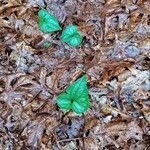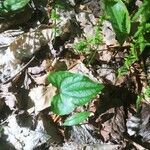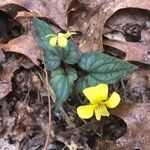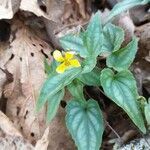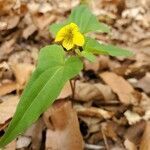Plants 0.5–2.5 dm from a long, slender, branching, brittle, white rhizome, glabrous or slightly puberulent; lvs 2–4 near the top of the stem, the blades halberd-shaped to oblong-cordate, 2–8 cm at anthesis, larger later, dark green, usually with irregular silvery blotches above, shallowly but saliently serrate; occasionally one long-petioled, reniform-cordate radical lf accompanies the flowering stem, and others may arise from the rhizome; fls on slender, erect, axillary peduncles; sep lance-linear, with scarious, eciliate margins; pet bright yellow with brown-purple lines toward the base, purple-tinged on the back; style bearded at the capitate summit; frs ellipsoid, 6–8 mm; seeds pale brown; 2n=12. Rich woods; Pa. and O. to S.C., n. Ga., and e. Tenn. Apr., May.
